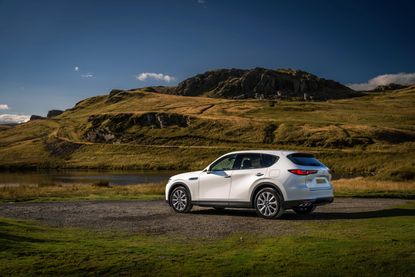Mazda CX-60: the brand moves into the big time with its first plug-in hybrid SUV
Mazda wants to capture the hearts of soft-roaders the world over with its new hybrid Mazda CX-60. Is this PHEV fab?
- (opens in new tab)
- (opens in new tab)
- (opens in new tab)
- Sign up to our newsletter Newsletter

If you were shown the side profiles of every mid-size SUV on the market, stripped of identifying badges, a keen eye would be needed to discern which one was which. This is a huge category of car, with SUVs making up around 45 per cent of all car sales.
For a volume manufacturer like Mazda (which built about 1.3 million cars in 2021) it’s clearly important to have a presence among the myriad SUVs. But how to make it different? For a while now, the Japanese company has set itself apart from the mainstream.

Mazda has been around since 1920, starting with cork manufacture, then moving on to rickshaws and ultimately cars. After a long-running partnership with Ford, it recently hooked up with fellow Japanese manufacturer Toyota, with whom it has a tech-sharing agreement. In the modern era, the company has excelled at making inexpensive small cars like the Mazda2 and Mazda3, as well as some perennially unfashionable and underrated mid-size saloons and estates (the Mazda6).
For now, Mazda is still best known for its long-running Mazda MX5, the world’s best-selling sports car, and for a streak of marketing that emphasises sprightly handling, performance, and a general feeling of joie de vivre across its range. It’s a tall order to distil this DNA into an SUV. Before the Mazda CX-60, there was the ill-fated MX-30, a neat-looking but range-hamstrung EV that represents a bit of an evolutionary dead end.
Mazda CX-60: a go-anywhere country runaround that doesn’t skimp on tech

First impressions of the Mazda CX-60 are similarly underwhelming. The bigger CX-60 doesn’t stand out from that aforementioned line-up of competitors, nor does it make much visual impact on the road.
The high flanks are broken up by an awkward crease that makes you double-take each and every time you approach the car, half-convinced that someone has just side-swiped it, while the wheel arches are given a pronounced, cartoonish crimp in an attempt to subdue the expanses of bare metal. At the front, the Mazda grille bleeds into the headlights on either side, a technique used by both BMW and Mercedes in recent years.

Mazda makes a great deal of its adherence to traditional Japanese design concepts like ‘Ma’ (‘the calm and dignified beauty of empty space‘) and ‘Hacho’ (described as ‘intentional unevenness’), as well as ‘Kaichou’, ‘an element of disruption which mixes different materials and textures’.
It’s a stretch to detect these in the CX-60, either inside or out, and they work best when deployed on Mazda’s concept vehicles, unconstrained by the limits of mass production and legislation.

Nevertheless, the CX-60 is a much more satisfactory story inside. You’d have thought there was no excuse for a badly designed car interior in 2022, but the truth is that the ultra-rapid evolution of personal technologies like smart phones and tablets has posed a massive headache for car designers, who don’t have the speed and resources to keep up.

Full touchscreen interiors are inevitably over-complicated or underwhelming, and Mazda has thankfully gone for an approach that mixes screens with dials. In ‘Takumi’ trim, it’s a very well-equipped, comfortable car, even if on-board technologies like See-Through View – which gives you an underbody view when off-roading – are likely to be under-utilised by many drivers.
The other aspect of Mazda’s ethos that the CX-60 struggles to convey is the driving experience. A firmly-sprung car gives a more dynamic and responsive driving experience. However, hybrids are not svelte, and as a result, the CX-60 is brutishly firm across rough roads and speed bumps. On the open road, it is substantially better, but doesn’t quite have the relationship to the MX-5 that a Porsche Macan has, say, to a Cayman.

So the CX-60 is not a town car, then. But given that it’s a hefty SUV, this should come as absolutely no surprise to anyone. In its favour, the CX-60 offers the same broad range of abilities as, say, a Range Rover, only at a fraction of the price. It might not align with Mazda’s self-image, but as a cut-price, go-anywhere country runaround that doesn’t skimp on tech, the CX-60 starts to make sense.
Mazda CX-60 EXCLUSIVE LINE, from £45,420, Takumi Grade edition from £48,050
mazda.co.uk (opens in new tab)
Jonathan Bell has written for Wallpaper* magazine since 1999, covering everything from architecture and transport design to books, tech and graphic design. He is now the magazine’s Transport and Technology Editor. Jonathan has written and edited 15 books, including Concept Car Design, 21st Century House, and The New Modern House. He is also the host of Wallpaper’s first podcast.
-
 Marre Moerel’s swinging flame candle uses artful balance
Marre Moerel’s swinging flame candle uses artful balanceVita Balanza by Marre Moerel and Santa & Cole has turned candles into a balancing act
By Martha Elliott • Published
-
 At home with Neri & Hu
At home with Neri & HuArchitectural super-pair Neri & Hu talk to us about what inspires them, what they are reading, and how they switch off
By Ellie Stathaki • Published
-
 Year in review: top 10 transport stories of 2022, as selected by Wallpaper’s Jonathan Bell
Year in review: top 10 transport stories of 2022, as selected by Wallpaper’s Jonathan BellTop 10 transport stories of 2022, from minimalist motor cars to next-generation campers: transport editor Jonathan Bell’s picks
By Jonathan Bell • Published


